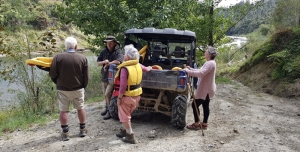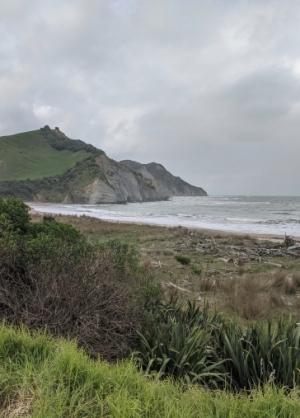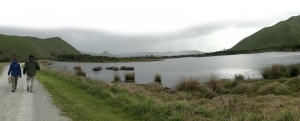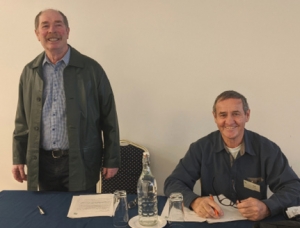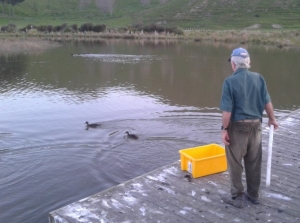Displaying items by tag: AGM 2020
Two nights west of the spiral
The winners of a DU auction for a Blue Duck Station experience had a ball. John Dermer reports.
It’s quite a drive! You turn west at Raurimu, famous for its railway spiral, and travel a windy gravel road till you are sure you are lost. When you come to a gate across the road, you’ve arrived.
The station buildings, including the Blue Duck Cafe, sit on a piece of flat land between the confluence of the Retaruki and Whanganui rivers. Our host, Dan Steele, has bought nearby farms as they had buildings on them
for the burgeoning staff that his tourism business needed.
The lovely old homestead that his parents, (“the olds”) live in is at the end of the road and has magnificent views up and down the Whanganui. The garden has some very old trees – oak, beech plus many fruit trees.
Kees and Kay Weytmans and Diny and I had arrived for our two-day stay. We had bought this at the DUNZ auction last winter and as we had had such a good time on Brian and Wendy Simmons' boat the previous summer, we thought we would try Dan’s Blue Duck Station experience this time.
We stayed in a sunny three-bedroom, three en suite lodge with communal kitchen, large dining table plus masses of outdoor seating. The rooms were fitted with quirky handles, hooks and knobs. Unfortunately we forgot to bring a gun to shoot the rabbits!
Dan and Sandy farm Blue Duck Station and neighbouring Retaruki Station, which they lease from his parents.
The total area is 7000 acres (2800 hectares) carrying 5000 ewes and replacements.
It’s mostly steep country – steep to overhanging for much of it, with bush and manuka scrub covering a lot of it. There is some easier country on it but I have to confess that I have been thoroughly spoilt running a small nearly flat farm for a long time now (actually 46 years). Dan, you can keep your hills!
The gorges are deeply incised with sheer papa sides, often showing evidence of a catastrophic rainstorm which lashed the area about two years ago. Not much use for stock water but great for whio.
Dan showed us around in a well-used side-by-side. The tracks are pretty good and he is a mine of information about the area, its history and the people who have lived here.
The station is right beside the Whanganui River, rich in Māori history and the major highway for many years.
One of the houseboats, floating hotels of the time, finished its days moored in the Retaruki just below Dan's parents' homestead.
We saw a beautiful stand of kahikatea (white pine), with other species, rimu, miro, matai and pukatea, growing as well. Dan told us about the well-appointed cave that someone had stumbled on in a sheer face nearby.
Mohawk Joe was growing pot on a well tended area nearby and living in the cave. The police just laughed when they saw it. Dan still says hello to Mohawk when he sees him.
The best story was from wife Sandy. She had only visited Blue Duck a couple of times but wrote in a visitor’s book that she was coming back soon. To marry Dan! Dan loves this country. He has just bought a block of 750 acres with about a third of it grazable. The rest is in native bush and scrub.
Not a block that was going to make him much money from farming but Dan had spotted a knob with a view of the mountains, Ruapehu, Ngāuruhoe, Tongariro.
This was reasonably accessible by ATV and he has a very good chef, Jack Cashmore, who happens to be a carpenter as well.
Hence they had the bright idea to build a high-class restaurant and three chalets up there. The plan is to have top-class fine dining and for people to enjoy a backcountry experience.
Typically, Dan has gone half-shares with the chef in the venture. They hope to finish the complex by September. Give Dan a call as it will be fabulous. I hope this venture goes well for them.
Dan’s business is now heavily slanted towards tourism. (We hardly heard a New Zealand accent the whole time we were there [pre-lockdown]).
He employs 12 people, many involved in tourism, so he was not a “happy chappy” to get the news about Covid-19.
This shut down the tourism side virtually overnight so he is now dependent on his farming and mānuka honey production, with carbon farming from the mānuka and some plantations which have been planted.
One very rough looking block had been planted in redwoods (Sequoia sempervirens) on advice from Horizons.
(I wonder how they will perform on this site.) Another block is in radiata so carbon farming should help through this rough patch.
The map in the Blue Duck Cafe showing Dan’s trap lines is very impressive. He has predator traps all over the place.
More than a thousand of them.
He is great man for doing deals with people who stay there. Free accommodation if you do a few days' rebaiting traps.
Not a great job when you have to remove a very smelly hedgehog. Rats are the main capture at the moment but Dan reckons he will never get rid of them.
We did see a pair of whio, happily sitting on rocks in the river, so all the effort he is putting into his predator control is obviously working.
A jet boat ride down the Whanganui was a highlight. The river is very low so Dan had to keep a sharp eye out for shallow rapids. Also for the many kayakers travelling downstream.
For those of you thinking the gray duck is on the way out, you should see the number on the Whanganui. They are plentiful.
I noticed the same thing many years ago in my own jet boating days, so the numbers seem to be hanging in there.
Mission impossible
Contractors wildlife expert Sandy Bull and Ecoworks' Steve Sawyer bring birdlife into Nick's Head Station and look after the 2-metres-high predator-proof fence, which protects 35 hectares of native bush and a wide array of wildlife.
About 60 tuatara were translocated from Stephens Island in Marlborough Sounds, and now, safe within the fence, their numbers have grown to more than 100.
There are also about 180 nesting gannets, about 55 to 60 grey-faced petrels, sooty and fluttering shearwaters and even an arctic skua has been seen within the fence.
"Initially, they said we couldn't do it," Sandy says.
To attract the seabirds, Steve smothered the rocks with white paint to look like guano and installed a sound system to replicate the calls of various seabirds. The gannets have been nesting there for several years now.
Sandy says there are plans to translocate saddlebacks and giant weta. He has also been involved in translocating pāteke to the wetland and about 200 have been released. He says they are now moving around the region and another survey of bird numbers is due but it is clear the pāteke are doing well.
Sandy told DU members that he was well aware of the wealth of knowledge within DU and members' involvement with wetlands around New Zealand.
He says Gisborne is desperately short of wetlands. The biggest is Lake Repongaere, covering about 110 acres. "There are farm ponds all over Gisborne attracting wildlife but we are very short of big wetlands. This one [at Nick's Head Station] is a joy to behold."
Some of the visiting and resident birds:
- pukeko – numerous (some have been culled);
- paradise shelducks;
- shags – black, pied, little, little black and kawau;
- white faced herons; bittern – though they are seldom seen;
- pied stilts;
- kōtuku;
- royal spoonbills;
- godwits – spotted recently;
- a nesting colony of black billed gulls, the world's rarest gull;
- black-fronted terns – spotted once; dab chicks;
- NZ scaups – in low numbers;
- graylards – interbred with mallards and grey teal;
- grey teals;
- shovelers;
- Canada geese; penguins – a colony on the beach;
- oystercatchers; pāteke;
- gannets;
- petrels;
- Arctic skuas;
- fluttering shearwaters;
- sooty shearwaters
DU's trip to a 'magic place'
The wetland at Nick's Head Station at Muriwai, south of Gisborne, is a world-leading example of positive human interactions with the land, and of what vision and money can achieve.
General manager Kim Dodgshun has worked at Nick's Head Station since 1994, eight years before the current owners bought the property. "They inherited me and we've worked well as a team ever since," Kim says.
When Kim arrived, the land that is now the main wetland was being grazed with livestock roaming all over, and with cows wandering along the beach. "It was nothing like it is today."
Early on, Kim had the idea of creating a bird reserve on the property and ran it past wildlife ecologist and former Wildlife Service ranger Sandy Bull.
The plan, however, hit a snag when the owners at the time said they did not wish to proceed with something that would not produce financial returns.
Undeterred, in 1995 Kim managed to obtain a $15,000 Natural Heritage Fund grant from the local district council and, with Sandy's help, starting trapping. "We caught a big polecat down on the beach," Kim says.
They also put up "No shooting" signs – it had been a popular duck shooting site, fenced off 15 hectares and planted flax around the outside. The birds flocked in, bringing seeds from other wetlands in the area and the plants began to grow.
The story of the wetland took another turn in 2003 when the farm changed hands after the Overseas Investment Commission approved an application from a US billionaire to buy the land, in what turned out to be a 12-month-long process.
He had first visited the farm in 2002 and embraced Kim's plans to create a wildlife reserve.
The final step for the sale was to gain iwi approval. Kim says communication was the key and once the iwi knew what the owner planned to do with the property, the deal was approved.
In response to Kim's plans, the owner said, "Let's make this bigger and better", and brought out renowned landscape architect Thomas Woltz from the US to design the wetland, with advice from Kim and Sandy.
A previous manager who had farmed there for 35 years had set in place the foundations to drain the saltwater from the low lying areas. He put up a netting fence on the beach which collected all the driftwood and storm debris, building a natural wall with sand.
Next, he added another fence on top of that and planted it out with marran grass and other plants.
Later, in the 1960s, a drain was put in to get rid of the remaining saltwater but a narrow, shallow channel remained, with 700 acres of catchment running into it. In summer it dried up. The surrounding paddocks were all very wet with no drainage.
Kim had already planted some native blocks but as Thomas Woltz learnt more about New Zealand and its trees, "the master plan was to revert the land back to how it was 700 or 800 years ago, with a profitable farming operation, back when there were no predators and the land was covered in native trees", Kim says.
Planting began in earnest in 2003 and now there's almost 700,000 natives on the property – coastal varieties with "the big fellas" – rimu, matai and totara – planted among them.
The wetland project began in 2005 – plans were drawn up, the land was surveyed and work began, initially with six diggers.
Kim had warned the contractors that trucks with wheels and 20-tonne diggers wouldn't work in the boggy terrain, but they brought them in anyway and all of them got stuck.
Which left the six smaller diggers. Firstly, a wall was put in to stop the saltwater coming in over the original wall at the beach. "We put in some more small ponds up the valley and worked our way west."
Deep channels – "about 2½-cars deep" – were dug out to ensure the wetland had water year-round.
The material excavated from the channels was made up of a layer of Plasticine-like blue tacky soil sandwiched between shells and "rubbishy" soil. The blue material was used to seal the walls or build the islands, while the "rubbishy" soil helped shape them.
Diggers scraped up the topsoil which was carted on to the shaped islands by trucks with tracks to prepare them for planting.
However, when they came to seal the western side of the wetland, they ran out of the blue soil so plastic liner had to be used in some sections.
"We pegged out all the walls and had three diggers in a row, one digging the holes, another with a big roll of the plastic, working at snail pace, unrolling it, with a third quickly filling it in before the walls collapsed," Kim says. Thankfully, it worked.
"Once it was all done, we had to pump all the water out. "We got council permission to pump it out into the sea over sheets of corrugated iron to protect the beach."
In the process, they found some old kahikatea, big, old stumps of trees, leading them to believe that, pre-settlement, it must have been an old kahikatea swamp.
"There are some stumps on the beach visible at low tide that have been dated at more than 8000 years old," Kim says.
As well as dealing with the challenges presented by the terrain, during planting, they encountered another problem.
Holes were dug with an augur, and some crystal rain put in with soil over the top before the tree was planted with a fertiliser capsule.
Later they went back to one of the islands to put in stakes to mark where the native plants were but found that most of them had been pulled out.
"All the rats were just pulling them out and eating the fertiliser caps. They were having a ball."
The answer was to use about 100 bait stations with Pestoff rat bait, from Farmlands, and "there were bucketloads of rats coming in," Kim says. It's slowed down now.
"That was just another little challenge. I can't believe how well the plants have grown."
Now the islands are all finished and planted with native trees – 10,000 trees to the hectare. On the hills, it's 2500 to the hectare.
The wetland has two 1ha islands and several smaller ones. All the islands are in place of valleys, which was Thomas Woltz's plan, imagining erosion coming down and islands forming.
At its peak, 25 people were working on the project. The labour was all local and all the trees were sourced from the Muriwai area. "Now the locals come to get our native trees," Kim says.
The farm is 3300 acres in total with nine kilometres of coastline. It runs Angus cattle, 285 breeding cows and 3300 sheep. This is likely to be reduced to 3200, with the aim of getting more out of fewer stock, by doing things better, "by selling them when they are ready to go and when the market is ready to take them".
"We are looking at the possibility of going down the regenerative farming path, though the steep contours of Nick's Head Station add to the challenge – more investigations in this area are required."
Facial eczema is a problem so the farm focuses on sourcing facial eczema-resistant stock. The farm uses dicalcic phosphate fertiliser, not straight superphosphate, and nitrogen, which was seldom used, has not been used for about eight years.
The station employs a staff of 16, who look after conservation, including a former DOC worker who does trapping and twice-weekly night shoots by bike, general hands, stockmen, groundsmen, a secretary, a citrus manager and assistant, who have 50 hectares of citrus to tend, plus contractors.
Kim pauses, distracted by something that needs fixing. "Everything we do on this place, we got to maintain it.
"We've got this magic place that we've all had something to do with and created what it is today. We can't let it go back. We can't let wild pine trees start growing.
"We've got convolvulus – we've got to keep taking it out – we've got kikuyu grass on the farm that we have been spraying, we have got to keep at it. "
"The old place never sleeps."
- The bus trip to Nick's Head Station was organised by Kees and Kay Weytmans, who provided delicious, nutritious packed lunches. Kees' efforts to make sure everyone was comfortable during the talks on the jetty by providing lucerne bales to sit on were also much appreciated.
- For more on Nick's Head Station, watch Thomas Woltz's Ted Talk at www.youtube.com/
watch?v=9VlY-3V63yI.
Good timing for get-together
President Ross Cottle welcomed DU members to the 46th Conference and AGM in Gisborne – the first time it has
been held there.
He said the turnout was better than expected after the Covid-19 lockdown. The timing of the conference, on the weekend of July 31 and August 1, turned out to be fortuitous, with the country facing further lockdown restrictions from August 11.
Ross thanked Kees and Kay Weytmans for organising everything at the Gisborne end.
PRESIDENT'S REPORT
Ross said it had been another relatively quiet year of activity, not helped by Covid-19.
Wairio continued to be a major focus for DU in the Wairarapa. The attempt to get a permanent water supply from Matthews Lagoon had not been very successful, with the wall of the diversion canal blowing out last winter.
It was yet to be reinstated although DU hoped it would be completed next summer.
DU was still seeking opportunities to advocate for wetland construction, and the promotion of environmental issues where needed.
"Our membership is holding, although there is noticeably more grey hair, and in some cases no hair at all, showing up to events each year," he said.
It was reported at last year's AGM that the Board had decided to offer scholarships to university students studying in the
wetland environmental area.
There had been a much slower uptake than expected, but in July, Adrienne Longuet-Bushell, Jim Law and Ross presented
Victoria University student Shannon Bentley with $5000 to continue her studies in carbon sequestration in wetlands.
Ross concluded by thanking the Board members for their work over the past 12 months.
FINANCIAL REPORT
Donations have come from the Wetland Trust, the Pharazyn Trust and Treadwells, and a one-off private donation.
Members' subscriptions and donations, along with last year's raffles and auctions contributed to the rest of the income, Treasurer John Bishop said.
DU accumulated $75,000 for the year and, once expenses were deducted, it was left with a surplus of $30,765, though a big portion of this is earmarked for work at Wairio.
John was this year’s Bill Barrett Trophy recipient.
WATERFOWL AND WETLAND TRUST
David Smith said that at the end of the trust's financial year, which is on December 31, it recorded its highest net assets at $522,000, but then there was Covid-19.
On March 23, the funds had taken a dive of just over $72,000, though this was also partly because of Donald Trump's trade war with China.
The trust sat tight and, as at July 22, the trust's funds were back to $505,000 as sharemarkets recovered much of their losses.
ELECTION OF OFFICERS
Three Board members – Adrienne Longuet-Bushell, Gill Lundie and Emma Williams – had completed their two-year
terms. All were re-elected unopposed for a further two years. Liz Brook has retired from the Board.
WETLAND CARE
DU assisted with two projects this year, both in the Masterton area.
Matt Wyeth, of Spring Valley Enterprises, is creating a wetland and pond of about 2 hectares which will complement the already extensive areas created in the past 20 years.
The cost would be more than $10,000, and DU would contribute $5000 towards it. It was due to be completed but had been delayed by Covid-19.
John Murray, of Kainga Mauru Trust, has also created an approximately 2ha wetland and pond. DU has contributed $5000 towards the $10,000 work required to do the excavations.
ROYAL SWAN
Will Abel said that sadly, there was nothing more to add this year, with no swans available.
"The breeding birds we have had over the years have departed the scheme, and we are having no success in replacing
them," he said.
"Even our strongest suppliers, Peacock Springs, are now needing breeding stock. We don’t really have any ideas how to
reverse the trend as importing birds is still not possible."
About 10 pairs had been seen on Henley Lake in Masterton, but there was no easy way to capture them.
MEMBERSHIP
Ducks Unlimited is stable with 275 members, of which 80 are non-paying or life members.
Reminders will be sent to those with outstanding subscriptions.
WEBSITE
The website is now mobile-friendly and the number of people accessing the site through their phones is nearly as high as those using desktop computers.
More copies of Flight magazines have been added to the website with 100 issues now online.
WAIRIO
Jim Law said the Wairio project was moving from a development stage to maturity.
The site was being visited by more people taking advantage of the grassed walkway around the wetland.
"Just watch your boots" because waterfowl are fond of parking up on it, he said.
DU continues to work with iwi who will be more involved with the management of Wairarapa Moana once their Treaty settlement is signed. "Our relationships with them are very good," Jim said. Greater Wellington Regional Council had taken over responsibility for the Matthews Lagoon and Boggy Pond reticulation project, but it had failed.
"We believe it will be fixed this summer." There was also debate within GWRC about the need for a fish passage at the site and this needed to be resolved.
The fantastic partnership with Victoria University was continuing, with students regularly working on Stage 3 at Wairio.
In July, the first Wetland Care scholarship was presented to a Victoria University student. The university also has another student who is likely to apply for a scholarship in the next two to three months.
DU has a five-year Wairio strategy which now needs to be updated. Also, its management contract with DOC expires in December 2021 so next year members will be asked about whether to continue that contract.
"There will be less work – we are just waiting for the trees to grow, some repairs and some planting. Our preference is most likely that we would continue," Jim said.
Ross applauded Jim's negotiation skills in dealing with the different Wairio partners.
Di Pritt asked the meeting to record a huge vote of thanks to Jim, Ross and the Wairio committee for their work. She said when they first visited the wetland 15 years ago, their first reaction was: "What are we doing?"
"It was the bleakest place – Siberia had nothing on it", and now it is a significant wetland, she said.
GENERAL BUSINESS
Fred Bailey asked how to access funds for predator control. It was generally thought regional councils should be the first point of contact.
Guest speaker Sam Gibson suggested contacting DOC's local relationship officer to tap into the DOC Community Fund and Jobs for Nature funding.
John Cheyne said Hawke's Bay Regional Council was the greatest source of resources in his region, as well as the DOC Community Fund.
AGM 2020 Minutes
Ducks Unlimited New Zealand 45th Annual General Meeting,
3 August 2019 9am, Quality Inn, Whanganui
President Ross Cottle welcomed members to the 45th Annual General Meeting. Welcome to guest speaker Murray Stevenson.
APOLOGIES:
Liz Brook; Dawn Pirani; Paul Pirani;
John Cheyne; Sharon Stevens-Cottle; Myra Smith; Glenys Hansen.
Motion: That the apologies tendered are accepted. Moved: John Bishop. Seconded: Jan Abel. Carried
MINUTES OF THE LAST AGM Circulated and copies available at the AGM.
Motion: That the minutes of the last AGM be accepted as a true and complete record. Moved: Will Abel. Seconded: Di Pritt. Carried
PRESIDENT’S REPORT – READ BY ROSS COTTLE
Moved: Ross Cottle. Seconded: Adrienne Bushell. Carried
Financial Report – John Bishop
Explanation of charitable trust requirements. Revenue stream Pharazyn, Treadwells, Muter Trusts, John Mortimer, South Wairarapa Rotary. South Island trip by Ross and Jim around $600 annually. Board of Directors expenses minimal, lot of meetings by Skype with annual trip to Ohakune.
Motion: That the financial report be accepted. Moved: John Bishop. Seconded: Di Pritt. Carried
Waterfowl and Wetland Trust Report – David Smith
The Trust is in good shape. The 2017 balance in Trust $516,000-ish, since then paid $40,000 to DUNZ. Currently $510,394, money paid out covered by Trust. Original fund $200,000 twenty years ago.
Motion: That the Trust report be accepted. Moved: David Smith. Seconded: John Bishop. Carried
Election of officers
Board selects President Ross Cottle, Vice-President Dan Steele, Director William Abel. Nominate Jim Law, John Dermer to stay on. Nominated: Di Pritt. Seconded: Jim Campbell. Carried
Wetland Care – William Abel
2019 short on projects, centred on Wairio and project in Masterton.
Royal swans – William Abel
No trip to South Island, no swans and no cygnets.
Website – Paul Mason
Membership – 280 members, 57 still to pay subs. Includes 61 life members, honorary members. Moving more to electronic payments. Survey done on email/post preference for communications. Flight magazine available on website, can be searched by subject. More of the earlier magazines are being scanned on to the website.
Wairio Wetland – Jim Law
Reticulation of water from Matthews and Boggy Pond. GWRC has done work reticulating. Less has been spent this year – about $5,000. Reticulation funded by GWRC – around $30,000. DUNZ has spent $220,000 in total on Wairio. Partners are GWRC doing predator control, DOC – cutting grass on track. Victoria University – research sites at Wairio, planting more specimen trees. Planting day in July with a good write-up in Times Age. Ross took reporter Piers Fuller around wetland who wrote a national article on Stuff. Restoration committee has $10,000 in Trust. Significant donation of $15,000 also in Trust. Members should feel proud of this project.
Whio, blue duck – Peter Russell
Released 72 birds, North Island around 30 at Blue Duck Station. First release in 2000 was 7 birds. Flocks in South Island in three areas. Tasman , concern because of mast year with success because of
trapping and 1080. Successful year.
Scholarship
Three-year trial of 4 students – $5,000 each, Victoria, Massey, Christchurch, Waikato. Possibility of 1 Victoria student in 2020 to work at Wairio. Emma has given suggestions to unis of topics of study.
General Ian Jensen – vote of thanks to Board members and for the organisation of the AGM weekend.
Meeting closed at 10am.
Land of the First Light
For this year’s annual conference and AGM, Ducks Unlimited members will head east to Gisborne, land of the first light.
The venue for the conference, being held on 31 July and 1 August, will be the Emerald Hotel in the heart of the city.
A treat is in store for the field trip, with Nick’s Head Station in Muriwai agreeing to let delegates and their guests visit its wetland on Saturday, 1 August. Organisers are arranging for three speakers during the wetland visit.
They are:
- Kim Dodgshun, manager of Nick’s Head Station – welcome and introduction
- Steve Sawyer, owner/operator of EcoWorks, which implements many conservation activities at Nick’s Head
- Sandy Bull, a driving force behind much of the conservation work in Gisborne.
Nick’s Head Station is by the ocean so an alternative may be required if the weather does not allow the visit to go ahead as planned.
At this stage it is suggested to have the speakers at the Knapdale Eco Lodge if the weather is too bad.
Knapdale is somewhat protected in poor weather so it may be possible to view the wetlands there instead.
But, with Gisborne having the second highest sun hours in the country, conference organisers are hopeful DU can visit Nick’s Head Station.

